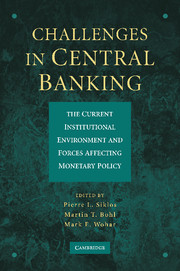 Challenges in Central Banking
Challenges in Central Banking Book contents
- Frontmatter
- Contents
- List of Tables, Figures, and Appendices
- List of Contributors
- Preface
- 1 The State of Play in Central Banking and the Challenges to Come
- PART I PAST, PRESENT, AND FUTURE IN THE CONDUCT OF MONETARY POLICY
- PART II THE SCOPE OF CENTRAL BANKING OPERATIONS AND CENTRAL BANK INDEPENDENCE
- PART III TRANSPARENCY AND GOVERNANCE IN CENTRAL BANKING
- Index
1 - The State of Play in Central Banking and the Challenges to Come
Published online by Cambridge University Press: 06 December 2010
- Frontmatter
- Contents
- List of Tables, Figures, and Appendices
- List of Contributors
- Preface
- 1 The State of Play in Central Banking and the Challenges to Come
- PART I PAST, PRESENT, AND FUTURE IN THE CONDUCT OF MONETARY POLICY
- PART II THE SCOPE OF CENTRAL BANKING OPERATIONS AND CENTRAL BANK INDEPENDENCE
- PART III TRANSPARENCY AND GOVERNANCE IN CENTRAL BANKING
- Index
Summary
Introduction
In 2006, the editors conceived the idea of holding a high-level conference to assess the state of play in central banking. At the time, the world economy was in the midst of what has come to be called the “Great Moderation” (Bernanke 2004). We felt that it was high time to take a step back and consider how central banking evolved over the past 20 years or so and the challenges that lay ahead for monetary policy. Little did we know that, soon after the conference – which was co-organized with the National Bank of Hungary – ended, we would enter a global financial crisis, which, as this is written, is still ongoing. Therefore, it is perhaps even more appropriate now not only to take stock of what has been accomplished and the lessons learned, but, perhaps equally importantly, to look ahead and consider what the future of monetary policy might be governed by.
At no time has the performance of central banks been more in evidence than in the last decade. Many central banks have embraced inflation targeting. Nevertheless, central bank behavior around the world differs in a number of respects (e.g., Siklos 2008, and references therein). These differences call for an up-to-date assessment of central banking. This book brings together some of the top researchers in the area of central banking; the chapters emphasize some of the most pressing issues in monetary policy today.
- Type
- Chapter
- Information
- Challenges in Central BankingThe Current Institutional Environment and Forces Affecting Monetary Policy, pp. 1 - 18Publisher: Cambridge University PressPrint publication year: 2010


